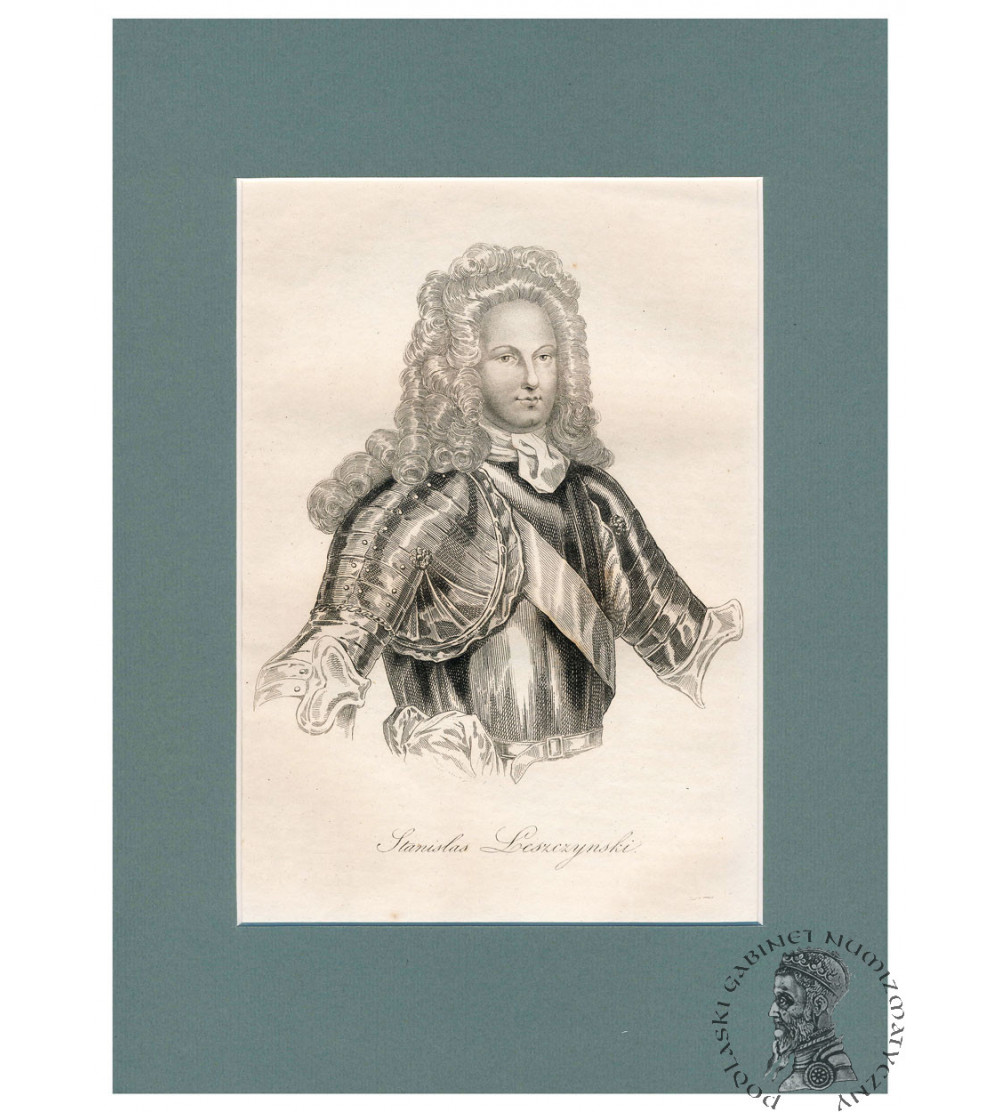




Stanislaw Leszczynski, King of Poland, portrait, steel engraving 19th century, work from Leonard Chodźko's volume - La Pologne historique, litteraire, monumentale et ilustree, Paris 1839-1841, all A4 format (passe-partout), image dimensions 14 cm x 20 cm, very good condition.
Stanislaw Leszczynski (1677-1766). Elective king of Poland and Duke of Lorraine. During the Great Northern War, he was one of the leaders of the opposition opposing the rule of Augustus II Sas. On July 12, 1704, under pressure from King Charles XII of Sweden, he was elected king of Poland, but not crowned until October 4, 1705 - against the ban of the apostolic capital. His position was sanctioned only by the forced abdication of August II the Strong in the summer of 1706. He remained in full dependence on the Swedes, and only stayed on the throne as long as Charles XII was successful in his battles with the Russians. After the Swedes lost the Battle of Poltava in 1709, he was forced to leave the country; he wandered around Europe for two years. In 1712 he reached a settlement with representatives of Augustus II, under which he relinquished power and returned to Saxon his act of abdication, but in return retained the right to continue to title himself king. Despite this agreement, a year later he undertook an unsuccessful expedition to Poland at the head of a combined Tatar-Turkish-Swedish force. The expedition ended in utter failure, and Stanislaw Leszczynski, as a consolation, received the microscopic Duchy of Two Bridges in Bavaria from Charles XII. Fortune smiled anew on the former king only in 1725, when his daughter Maria married the teenage French ruler Louis XV. With French support, Leszczynski made another attempt to return to the throne. During the election of 1733, with the help of his father-in-law's financial largesse, he led to his election as king. However, the decision of the nobility provoked a strong armed reaction from neighboring powers - Russia, Austria and Saxony - who invaded the Republic to secure the crown for the son of the late Augustus the Strong: Augustus III Saxon. Leszczynski held out for several more months in besieged Gdansk, after which he was forced to flee disguised as a peasant. At the decisive moment, the French court abandoned the military defense of its protégé's interests in favor of August III. By way of a compromise reached with Austria, in 1736 he was given the duchies of Lorraine and Bar for life, which were to become part of France after his death as Queen Marie's outstanding dowry. He was the longest-lived king of Poland. He died at the age of 88 from burns suffered when his clothes caught fire from a fireplace. He was buried in the Church of Notre-Dame de Bon Secours in Nancy. The church was destroyed during the French Revolution, and the royal remains were twice profaned. In June 1814, they were taken by Michal Sokolnicki and transported to Poznan, with the intention of being buried in Wawel Cathedral. From then on, their fate was unknown until 1924, when they were found in the vaults of St. Catherine's Church in Leningrad, from where they were smuggled to the Royal Castle in Warsaw. In 1926 they were moved to one of the halls of the Wawel Royal Castle, from where they were transferred to Wawel Cathedral in 1938, first to the Batory crypt, then to the Sigismund crypt. source: ciekawostkihistoryczne.pl
CHODŹKO, Leonard Borejko (1800-1871), La Pologne historique, litteraire et monumentale, (...), 1835-1842. A monumental work by the famous Polish émigré publisher Leonard Chodźko which is a history and geographic-political description of Poland. The work was published in three volumes. The first part is the history of Poland from the earliest times to the reign of Wladyslaw Lokietek. The second volume covers the history of Poland from the reign of Casimir the Great to the death of Stefan Batory, while the last volume covers the history of Poland from the beginning of the reign of Sigismund III Vasa until the events contemporary to the Author and the Readers, i.e. the November Uprising. Each part also contains descriptions of unique and interesting places in Poland, as well as basic information about literature, art and science. In addition, the work contains examples of exceptional monuments in the Polish lands. An important part of the work includes fairy tales, legends and short stories, as well as an essay on dramatic theater in Poland. The work also contains a description of Polish dances, such as the polonaise, mazurka, and krakowiak. The work is very richly illustrated, with numerous intaglios, natural monuments, sacred objects, castles, palaces, cities, portraits of important historical figures from the history of Poland, works of art, notes of songs, etc. This brings the total to 180 engravings (including maps), in a set of three volumes, i.e. 60 engravings for each volume collated with a table at the beginning of the volume.